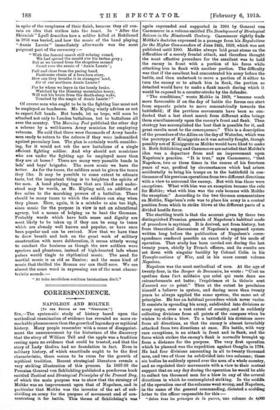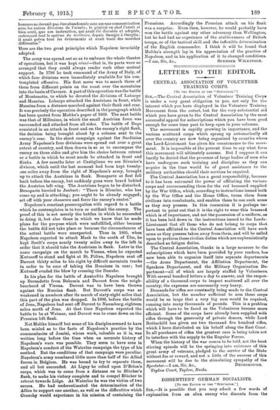CORRESPONDENCE.
NAPOLEON AND MOLTKE.
IT0 Ma EDITOR 01 SMORMOR.'l
11,—The systematic study of history based upon the methodical examination of evidence has revealed no more re- markable phenomenon than the growth of legendary or mythical history. Many people remember with a sense of disappoint- ment the announcement by the historians of the discovery that the story of William Tell and the apple was a tradition resting upon no evidence that could be trusted, and that the story of Lady Godiva bad no foundation in fact. Even in military history, of which exactitude ought to be the first characteristic, there seems to be room for the growth of mythical tradition. Recent strategical literature reveals a very striking illustration of this process. In 1897-98 the Prussian General von Schlichting publiabed a ponderous book entitled Tactical and Strategical Principles of the Present Day, of which the main purpose was to show that the strategy of Moltke was an improvement upon that of Napoleon, and in particular that Moltke was the inventor of the art of sub- dividing an army for the purpose of movement and of con- centrating it for battle. This theme of Schliclating'e was
again expounded .and supported in 1904 by General von. Caemmerer in a volume entitled The Development of Strategical Science in the Nineteenth Century. Caemmerer rightly finds Moltke's doctrine expressed in a passage from his Regulations for the Higher Commanders of dune 24th, 1869, which was not published until 1900. Moltke always Iaid great stress on the difficulties of a merely frontal attack, and therefore thought the most effective procedure for the assailant was to hold the enemy in front with a portion of his force while attacking him in flank with another portion. The difficulty was that if the assailant had concentrated his army before the. battle, and then undertook to move a portion of it either to- turn the enemy or to attack him in flank, the portion so detached would have to make a flank march during which it would be exposed to a counter-stroke by the defender.
"Thu conditions," wrote Moltke in 1869, "become much more favourable if on the day of battle the forces can start from separate points to move concentrically towards the battlefield; if the previous movements have been so con- ducted that a last short march from different sides brings them simultaneously upon the enemy's front and flank. Then strategy has accomplished the best that is possible for it, and great results must be the consequence." This is a description of the procedure of the Allies on the day of Waterloo, which was the prototype of Kiiniggiiitz as it was actually fought, though possibly not of IDiniggratz as Moltke would have liked to make it. Both Schlichting and Caemmerer are satisfied that Moltke'a idea was a departure from and an improvement upon Napoleon's practice. "It is true," says Caemmerer, "that Napoleon, two or three times in the course of his fourteen years of war, profited by circumstances which had arisen accidentally to bring his troops on to the battlefield in con- tinuance of his previous operations from two different directions with a view to surround the enemy, But with him these were exceptions. What with him was an exception became the rule for Moltke; what with him was the rule became with Moltke the exception,' According to the two German commentators on Moltke, Napoleon's rule was to place his army in a central position from which to strike blows at the different parts of a divided hostile force.
The startling truth is that the account given by these two distinguished Prussian generals of Napoleon's habitual mode of procedure is mythical. It is derived, not from history, but from theoretical discussions of Napoleon's supposed system written long before the publication of Napoleon's corre- spondence rendered possible an exact study of his mode of operation. That study has been carried out during the last twenty years, chiefly by French officers, and its results are set down with singular lucidity by Colonel Colin in his Transformations of War, and in his more recent volume Napoleon.
Napoleon was the most methodical of men. At the age of twenty-four, in the Soaper de Beancaire, he wrote " C'est an systhme dans l'art militaire qua celai qui mate dans sea retranchements eat beau; l'experienee et la theorie sent d'accord sur ce point." Thus at the outset he proclaims himself a believer in system, and during more than twenty years he always applied the same system, the same set of principles. He has an habitual procedure which never varies. It consists in spreading his army, subdivided into divisions or army corps, over a vast extent of country, and in suddenly collecting divisions from all points of the compass when he wishes to strike a blow. To a battlefield his divisions move from all directions, so that the enemy is almost invariably attacked from two directions at once. His battle, with very rare exceptions, is an attack in front and in flank, and the force which strikes the enemy's flank is normally brought up from a distance for the purpose. The very first operation which he planned was the expedition against Oneglia in 1794. He had four divisions amounting in all to twenty thousand men, and two of these lee subdivided into two columns ; these six bodies he suddenly spread over the area of a whole country, and so regulated their movements with a view to their mutual support that on any day during the operation be would be able to collect ten thousand men fora blow in any of the several directions in which he contemplated striking. In the middle of the operation one of the columns went wrong, and Napoleon, in the name of the general commanding, dictated a scolding letter to the officer responsible for this :— "SOIOR ions lee prireoipes de is plow, vine eolonne de 41000 bommes ne devrait pas etre abandonnee sans aucuno communication avec los autres divisions de l'armee ; to general en chef l'avait si hien senti, qua son instruction, qui avait ate discutde et adeptly, embrassait tout to systente du territoire, depuis Saorgio d Oneglia; it avail prevu toes les evenements et avait truce des marches differentes."
Here are the two great principles which Napoleon invariably adopted.
The army was spread out so as to embrace the whole theatre of operations, but it was kept rani—that is, its parts were so arranged that they could always render each other mutual support. In 1796 he took command of the Army of Italy, of which four divisions were immediately available for his con- templated offensive. His first move was to march three of them from different points on the coast over the mountains into the basin of Camara A part of this operation was the battle of Montenotte, to which he devoted the divisions of Laharpe and Massena. Labarpe attacked the Austrians in front, while Massena from a distance marched against their flank and rear. It was precisely the operation described in the paragraph which has been quoted from Moltke's paper of 1869. The next battle was that of Millesimo, in which the small Austrian force was surrounded and attacked from all aides. The battle of Dego consisted in an attack in front and on the enemy's right flank, the decision being brought about by a column sent to the enemy's rear. In the short campaign against the Sardinian Army Napoleon's four divisions were spread out over a great extent of country, and then drawn in so as to encompass the enemy on three sides and give him the choice between retreat or a battle in which he must needs be attacked in front and flanks. A few months later at Castiglione we see Sernrier's division, which until the last moment had been kept twenty- one miles away from the right of Napoleon's army, brought up to attack the Austrians in flank. Bonaparte at first fell back before the enemy, but suddenly guns were heard behind the Austrian left wing. The Austrians began to be disturbed. Bonaparte hurried to Joubert: "There is Sernrier, who has come up and is attacking; you ought to be already engaged; set off with your chasseurs and force the enemy's centre."
Napoleon's constant preoccupation with regard to a battle which he contemplates is to turn or outflank the enemy. The proof of this is not merely the battles in which he succeeded in doing it, but also those in which we know that he made plans for the purpose which were unfulfilled, either because the battle did not take place or because the circumstances of the actual battle were unexpected. Thus in 1805, when Napoleon expected to attack Mack to the south of Ulm, he kept Soult's corps nearly twenty miles away to the left in order that it should take the Austrians in flank. Later in the same campaign on the march to Vienna, when he expected Kutusoff to stand and fight at St. Patten, Napoleon sent off Devout thirty miles to his right by difficult mountain tracks in order to be sore of taking the Russians in rear; but Kutusoff evaded the blow by crossing the Danube.
In his plan for the battle of Austerlitz Napoleon brought up Bernadotte from Bohemia and Devout from the neigh- bourhood of Vienna. Devout was to have been thrown against the Russian flank. But Davout's corps was no weakened in numbers after its march of sixty-eight miles that this part of the plan was dropped. In 1806, before the battle of Jena, Napoleon had sent off Devout to Naumburg, eighteen miles north of Jena. At that time Napoleon expected the battle to be at Weimar, and Devout was to come down on the Prussian left flank.
Not Moltke himself but some of his disciples seemed to have been misled as to the facts of Napoleon's practice by the commentaries of Jomini, whose work, valuable as it ia, was written long before the, time when an accurate history of Napoleon's wars was possible. They seem to have seen in Napoleon's conduct of the Waterloo campaign the type of his method. But the conditions of that campaign were peculiar. Napoleon's army numbered little more than half of the Allied forces in Belgium. He was bound to try to separate them, and all but succeeded. At Ligny he relied upon D'Erlon's corps, which was to come from a distance on to Elficher's flank, to make his victory complete and to compel Blficher to retreat towards Liege. At Waterloo he was the victim of two errors. He had underestimated the determination of the Allies to support one another, as well as the difficulties which Grouchy would experience in his mission of containing the
Prussians. Accordingly the Prussian attack on his flank was a surprise. Even then, however, he would probably have won the battle against any other adversary than Wellington, but he had had no experience of the stubbornness of British troops, or of the tactical skill and the inflexible determination of the English commander. I think it will be found that Moltke's strength lay in his appreciation of the practice of Napoleon, and in his application of it to changed conditions.







































 Previous page
Previous page